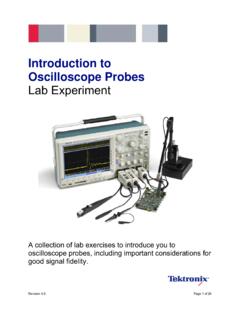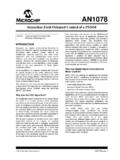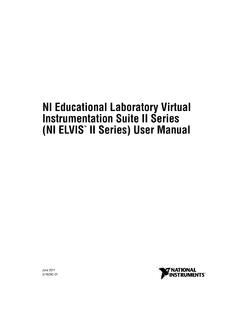Transcription of Reducing noise on the output of a switching regulator
1 Texas Instruments 1 ADJ 1Q 2018 PowerAnalog Design JournalReducing noise on the output of a switching regulatorIntroductionCompared to linear regulators, DC/DC converters provide great efficiency for voltage regulation. However, they have an undeserved bad reputation when it comes to systems with sensitive signal paths because of the noise they can generate. On top of their output -ripple noise , they also generate conducted or radiated electromagnetic interfer-ence (EMI).This article presents several solutions to reduce noise generated by DC/DC converters and includes test data that illustrates the trade-offs between noise reduction and efficiency performance.
2 These solutions include using a boot resistor, snubber circuit, ferrite bead and feedthrough capacitor, all implemented with TI s TPS54824 step-down techniquesBefore covering how the addition of discrete circuitry reduces noise , let s first cover the inductor-capacitor (LC) components used and the proper measuring technique. When measuring the switch node or output of a DC/DC converter, it is bad practice to use the alli-gator clamp for ground on the oscilloscope probe. Instead, take the measurement using the tip-and-barrel technique, which will provide a more accurate waveform. Many other articles recommend using this exact technique but give it a different is another method that was found to be even better than tip and barrel for measur-ing signals with low amplitude.
3 Given its difficulty to implement, it may or may not be a viable option. This method involves using a coax connection on the output of the converter and directly connecting it to an oscilloscope through a Bayonet Neill-Concelman (BNC) connection. The advantage of this technique is that the measurement is 1-to-1 ratio, compared to 10-to-1 for a typical probe. With a standard 10-to-1 probe, the noise in the measure-ment is amplified 10 the evaluation test board, a subminiature version-A (SMA) coax connection was added to the output of the converter. By then connecting to the oscilloscope with a SMA-to-BNC cable, better waveforms were obtained than when the tip-and-barrel technique was used.
4 Figure 1 shows the substantial improvement in the measurement with the coax selectionMany data sheets cover how the inductor and capacitors affect the output ripple, and even include equations, so that information is not covered here, with one exception. The inductor s self-resonant frequency can drastically affect the output ripple of the converter. To illustrate the problem, note that Figure 2 shows the output ripple of a buck converter with a 1- H inductor and four 47- F ripple shown in Figure 2 has two parts: the low-frequency (LF) ripple and the high-frequency (HF) noise . The LF ripple is at the switching frequency of the converter and depends on the output filter inductance and By Dylan HubbardApplication EngineerFigure 1.
5 Tip-and-barrel versus coax waveformsMeasurement (10 mV/div)Time (100 ns/div)42 Tip andBarrelCoaxFigure 2. Original output ripple for the TPS54824 LFRippleV(5 mV/div)OUTHFN oiseTime (400 ns/div)Texas Instruments 2 ADJ 1Q 2018 PowerAnalog Design Journalcapacitance. The HF noise comes from the coupling of the switch node s high-frequency ringing through the parasitic capacitance of the inductor (the oscilloscope must have enough bandwidth to capture this, typically 200 MHz).HF noise can be very harmful to systems with sensitive signal chains. All integrated circuits (ICs) have a power-supply rejection ratio (PSRR) that enables the VCC pin to reject a certain amount of noise coming from that power rail.
6 At higher frequencies, this PSRR value decreases, allowing the HF noise to couple through more easily. That s potentially 20 mVpp of noise getting into the signal is where it becomes critical to take a close look at choosing the inductor. To account for high-frequency noise , an inductor was selected with a higher self-resonant frequency to minimize the parasitic capacitance at the frequency of the noise . Figure 3 shows the resulting output inductor value was the same at 1 H and the current ratings were similar as well. But increasing the self-resonant frequency reduced the output ripple by over 50%.
7 The important trade-off to this improved perfor-mance is the size of the inductor. The original inductor was 6 by 6 by 3 mm and the inductor with higher self-resonant frequency was 8 by 8 by 7 mm. An inductor this size can take up too much space in many applications, so additional solutions must be considered to reduce resistorA boot resistor is the easiest and most conservative solu-tion that can reduce noise when it comes to spatial density and efficiency. Placing this resistor in series with the boot-strap capacitor provides a charge to the gate driver of the high-side metal-oxide semiconductor field-effect transistor (MOSFET).
8 The purpose of the resistor is to slow the turn-on time of the high-side MOSFET by impeding the current charging the gate, which will reduce the initial peak amplitude of the switch-node 4 shows the switch-node waveform of the test board with the original components and no added circuitry. Figure 5 shows the effects of adding a 3- boot resistor, which reduced the maximum voltage at the switch node by roughly 3 V. The resistor value is propor-tional to the reduction in ringing. However, too much resistance can negatively affect the functionality of the DC/DC converter. Most data sheets give a range of values for the boot resistor that are safe to use without starving the 3.
9 output ripple with an inductor with a high self-resonant frequencyV(5 mV/div)OUTTime (400 ns/div)Figure 4. Original switch-node waveform for the TPS54824 Switch Node (10 V/div)Time (10 ns/div)Figure 5. Switch-node waveform with a boot resistorSwitch Node (10 V/div)Time (10 ns/div)Texas Instruments 3 ADJ 1Q 2018 PowerAnalog Design JournalReducing the ringing also reduces the output ripple because the high-frequency noise correlates to the ringing. Figure 6 shows the output ripple with the boot resistor to Figure 2, Figure 6 shows a reduction in the resulting output ripple by roughly 8 mV. Again, the greater the resistance, the lower the only is the boot resistor helping with output -ripple reduction, but it also helps with radiated EMI reduction.
10 Lowering the initial peak of the ringing reduces the magni-tude of the EMI created by the switching . To explore the benefits of EMI reduction for a real-world application requiring low noise , see Reference 1. Snubber circuitA snubber circuit contains a resistor and capacitor that should dampen the switch-node ringing by absorbing the energy stored in the parasitic elements of the MOSFETs and printed circuit board (PCB). For more detail about designing a snubber circuit, see Reference 2. The test board used a 330-pF CSNUB and an RSNUB. The switch node connects to ground through these two passive components.













